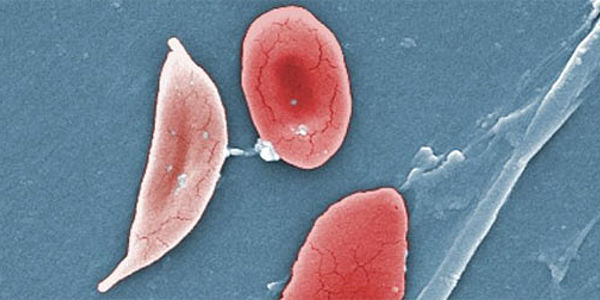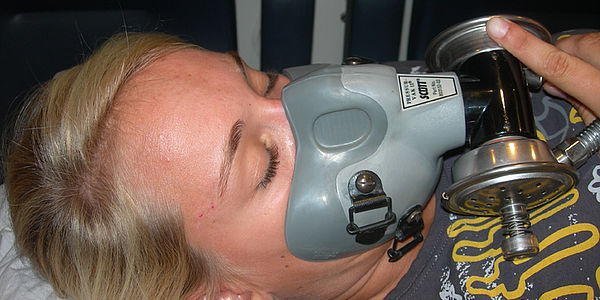With a toxic harpoon – the cone snail
Due to the colourful and interesting texture of their shells, cone snails are often a collector’s item during a vacation near the ocean. At times, the collector is rather rewarded with a painful or even poisonous/deadly sting than with the desired shell trophy. Only education and specific knowledge about cone snails, their appearance, activity and toxicity can prevent accidents and disturbance of health and also leaving these animals where they belong: in the sea. People must be warned against a carefree handling of those animals!
Taxonomy:
Mollusca; Gastropoda; Archaeogastropoda; Toxoglossa; Conidae. Conus are a large genus of small to large sea snails, marine gastropod molluscs, with the common names of cone snails, cone shells or cones. They are active poisonous marine animals using the toxin to hunt. The poison is "taken parenterally (= without the need to pass through the digestive system of the victim), in contrary to a "passive poisonous" sea creature where the poison works by eating them (through the digestive tract e.g. blowfish).
Identification:
The shell of the cones is in the form of a many-whorled, geometric rolled inverted cone, sometimes also oval shaped. The larger species, such as C. geographus, reach a length of up to 15 cm. Their shells are variable and often strikingly beautifully patterned; although in some species the colour patterns may be partially or completely hidden under an opaque layer of algae (see pictures). There is app. 500 different species of cone snails from which only few are seriously dangerous to humans – but the most poisonous ones are usually the most beautiful ones (Conus textile, Conus geographica etc….). Conus mediterraneus – endemic in the Mediterranean Sea –is commonly harmless for men. Depending on the prey that different Conus species specialize in hunting, the venoms are specifically active against worms, snails or fish. The venoms of fish-eating species, such as C. geographus, appear to be particularly dangerous to humans. However, envenoming in humans has also been caused by those species that specialize in invertebrate prey, such as C. textile.
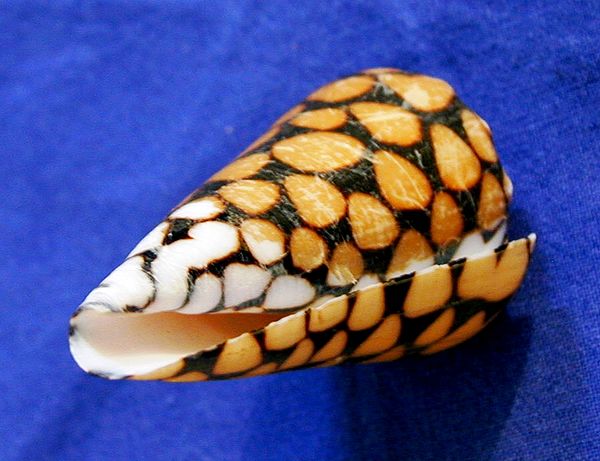
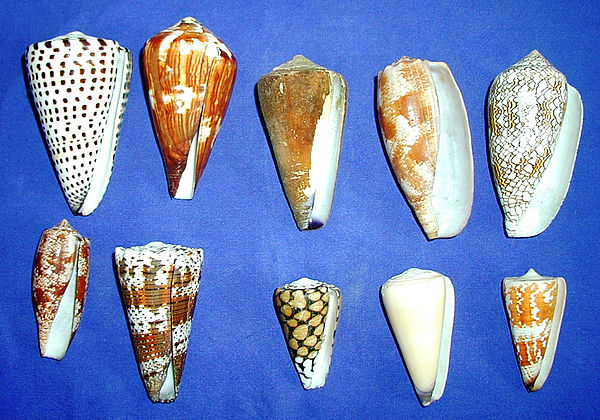
Distribution:
Cone snails can be found in warm seas and oceans around the world. A great many and the most poisonous species can be found in the Indo-West Pacific region, but also in the Atlantic Ocean and Westafrica. Conus mediterraneus (= C. ventricosus) the only and mostly harmless species in the Mediterranean.
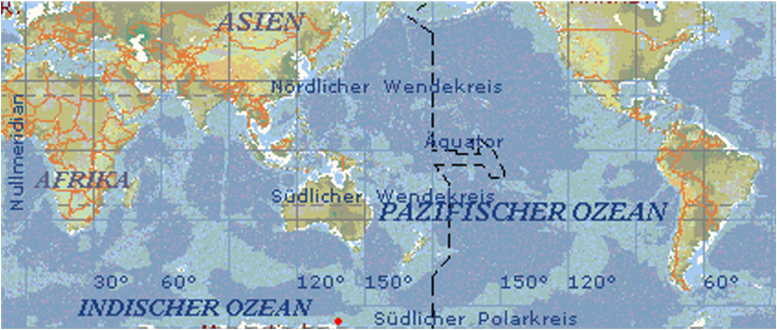
Activity:
Cone snails are nocturnal active predators; they live in tidal waters under rocks or in coral reefs. During the day, they will often bury themselves under sand. They can be found even only a few centimetres below the surface, during low tide also right on top of the reef or on the beach where they fall a victim of shell collectors – or – vice versa – the shell collector falls a victim of a cone snail. Being probably the slowest predator in the sea, the poison armed arrow is used to immobilize the pray. Within a very short time after being hit, the pray (worm, snail or fish) gets paralysed giving the slow snail enough time to approach its meal. To be able to feed on bigger pray, the cone snail has a huge mouth (siphon), which can extend outwards to engulf its prey.
Venom Apparatus:
regardless of the type of prey animal, the venomous apparatus is uniformly built in all cone snails. It is a complicated biological marvel of nature. The venom apparatus consists mainly of three structures: the venom duct, the venom bulb and the harpoons. The venomous toxins are produced in the venom duct (1), which is attached to a large bulb called the venom bulb (2). The venom bulb contracts to push venom into the harpoons. The harpoons are evolutionarily modified teeth (4) that are stored in a radular sac (3). Once the cone snail uses a harpoon to inject venom into its prey, it is discarded. The snail must reload another harpoon before it can strike again. Thankfully for snail, they have around twenty harpoons at various developmental stages in storage so a snail will always have another harpoon ready to load and use. The harpoons have an astonishingly wide radius and can easily penetrate a thin diver’s glove – therefore: hands off!
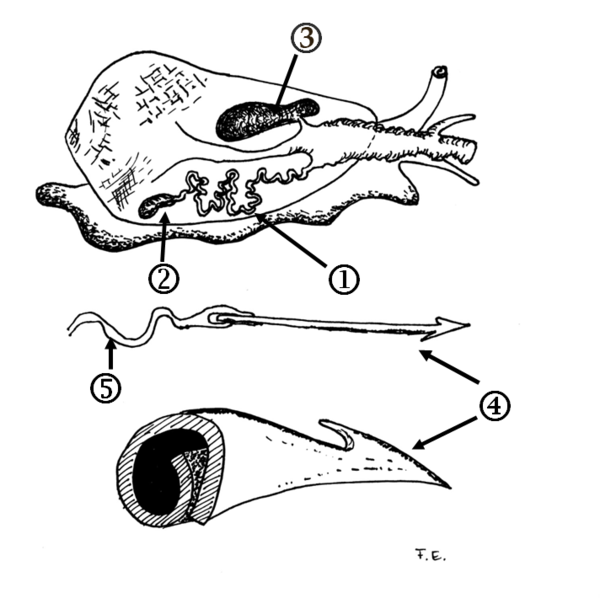
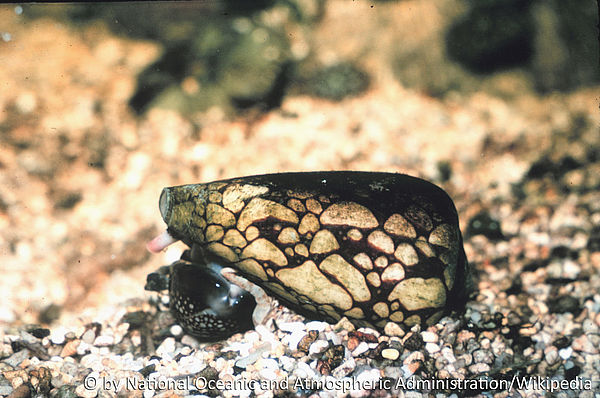
Poison and Toxin:
Terminology: it is important to be aware, that there is a big difference in between a poison and a toxin.
A poison is a cocktail of various substances which are harmful for a body if they exceed a certain concentration. For example the poison of a bee consists of a variety of substances including toxins. Likewise the poison of a cone snail. A toxin is basically of natural origin and is – chemically seen – a pure substance and clearly identifiable. Toxins are ingredients of poisons and hardly occur as a solitary substance.
The measuring unit for the toxicity of a toxin is the so called LD50. LD 50 determines the average lethal (deadly) dose rate which leads to death in laboratory test animals in 50 % leaving the other half alive. Of course, those findings can only be conditionally transferred onto humans, hence the LD50 is a point of reference and guidance level for the "Richter Scale" of toxicity. The smaller the LD50, the more toxic is a substance. 12-30 µg/kg of the toxin of a cone snail is enough to kill 50 % of the test animals, whereas one needs 10 000 µg/kg of sodium cyanide.
The toxin of the cone snail varies in type according to the type of prey animal, thus only effective either in worms, snails or fish. The venom is made of a small number of amino acids. Cone snails have the ability to make hundreds of toxins and deliver a cocktail or mixture of toxins when injecting its venom. The toxins of the cone snail are called Conotoxins and are one of the most effective toxins scientifically known. The life-threatening condition after envenoming is caused by interference of the neuromuscular conduction thus leading to extremely effective muscle paralysis. It is mainly caused by the toxins of the fish-hunting cone snail. Lethal cases are well documented.
Symptoms:
As mentioned, handling a cone snail is risky! On the one hand, the snail retreat so much back inside the cone that it appears to be empty. On the other hand, the siphon can extend widely outside the cone, that the harpoon can well reach the collectors hand. A sting might happen unnoticed or with symptoms similar to a bee sting. App. 7-20 minutes after the first pain sensation, the usual reactions are expanding swelling and numbness around the puncture site. The numbness can expand in size involving the whole extremity (mostly upper extremity, arm) and may deteriorate in paralysis of the whole body. The extend of muscle paralyses is determined by the amount and type of the toxin and the seize of the specific cone snail. Cones bigger than 10 cm are considered to be very dangerous and poisonous.
First symptoms of a severe poisoning are weariness, fatigue, speech and vision disorders as well as dysphagia (problems to swallow). In the further course, the victim might develop coordination disorders, disturbance of consciousness, unconsciousness and lethal respiratory paralyses. In case of survival, immune reactions and muscle weakness are recorded – this could possibly last for months.
Therapy and First Aid:
There is neither specific therapy nor an antidote! Therefore, immediate symptom-related first aid is crucial:
- Immediate exit out of the water
- Reassurance of the victim
- Hot water method (careful not to cause severe burns!)
- Immediate transportation to a medical facility. Speed saves a life!
- In case of respiratory arrest: mouth-to mouth and nose ventilation
- Medical monitoring for a minimum of 24 hours, even in light cases. Stabilization of the respiratory and circulatory system, intubation and ventilation. Paralysis may reverse after a couple of hours. Medicaments such as cortisone or anti-allergic drugs hardly influence or improve the natural course of the poisoning.
In general, we see what we know and what we are familiar with – for example the cone shell. Education is key to avoid accidents, especially in case of children who like to collect things.
Thus, we can avoid that a cone shell falls victim to a person – or a person falling victim to the cone shell.
Note:
Cone snails paralyse their prey with their venom, which blocks certain channels in the body. Some of these channels are related to how our brains perceive pain. Scientists have been able to separate toxins from the venom mixture, sequence and purify the peptides and modify the toxins to only work on certain channels related to pain. Drugs are being developed from this venom that can block specific pain that is otherwise untreatable or poorly managed. Current research is focused on finding successful ways to use cone snail venom to help people.
Literature:
Venomous and Poisonous animals
A Handbook for Biologists, Toxicologists and Toxinologists, Physicians and Pharmacists Mebs, Dietrich
Wissenschaftliche Verlagsgesellschaft Stuttgart 2002, ISBN 978-3-8047-5023-4

